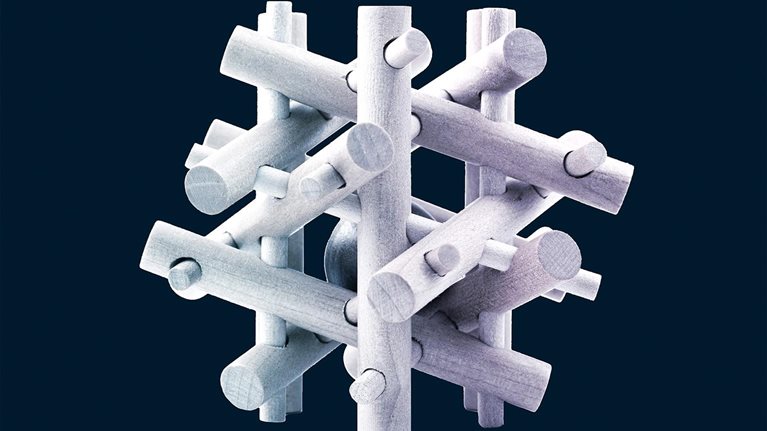The performance gap is widening between companies that are on the path to making technology a competitive advantage and those that are not. Businesses that adopt a tech-centered operating model position themselves to reap considerable potential benefits,1 including operational efficiencies, employee satisfaction, new revenue streams, and substantial increases in total shareholder return. However, few industrial companies are following this approach. In fact, many continue to treat IT as a cost center that reports to the CFO instead of recognizing its strategic role in propelling efficiency, profitability, and innovation across all business units.
Awareness that technology centricity is no longer an alternative—but an imperative—is growing. Consequently, nearly half (44 percent) of top-performing companies in all industries have adopted product- or platform-centric operating models (Exhibit 1). Adoption of this model in industrial-sector companies has lagged behind nonindustrial companies—15 percent versus 26 percent, respectively. Nonetheless, McKinsey experience signals a growing shift toward such operating models in the industrial sector in the near and long term to help accelerate companies’ transitions to fully digital, agile organizations.

This article explores how industrial-sector companies can benefit from adopting a product and platform operating model that aligns technology with their business objectives. It is crucial to build this model with a deep understanding of considerations specific to industrials to ensure effective and sustainable implementation.
A product and platform industrial operating model: Value and potential
If implemented thoughtfully and appropriately, a product and platform operating model ensures that technology is central to the organization, supporting and amplifying its capabilities in substantial ways. This benefits customer experience, decision making, and efficiency in ways that create measurable improvements in business outcomes.
Enhanced ability to serve customers
The products and services provided by industrial players are becoming increasingly reliant on technology components. Adoption of direct-to-consumer (D2C) business models is expanding, as is customer engagement’s reliance on digital services. A well-established product and platform operating model can facilitate the transformation to digital centricity. A mature operating model can also help industrial players gain an edge on their competitors, especially in customer service (Exhibit 2).

Indeed, fully integrated and robust data and analytics can improve many business decisions, such as identifying which customer segments to address.
Increased profitability
McKinsey experience has shown that companies that implement a product and platform operating model that integrates business and technology consistently achieve significant improvements in efficiency and quality while unlocking digital transformation. And according to McKinsey research, industrial players with mature operating models create above-average returns for shareholders (Exhibit 3).

Dedicated teams, clear missions: Optimizing product and platform operations
A product and platform operating model integrates digital and IT functions on teams within all business units in an organization. Products are customer- or employee-facing, such as retail websites and sales and ordering systems. They are closely linked to central business objectives and can change rapidly and iteratively. Platforms, such as enterprise resource planning (ERP) systems and HR and data platforms, provide the underlying capabilities that support multiple products. Delivery teams are organized around these products and platforms. Product and platform teams are small, empowered with the appropriate capabilities, and have clear missions (Exhibit 4).

An industrial organization operating model that supports the evolution of technology from cost center to key differentiator builds on six principles:
1. Aligning cross-functional teams with business domains fosters efficiency
In traditional business models, IT departments are structured around functional silos such as planning and design, development, and operations. While this configuration allows for specialization within a function, it requires a considerable number of handoffs rather than supporting end-to-end ownership across the software development life cycle.
McKinsey’s experience indicates that digitally mature companies are shifting to cross-functional teams equipped to design, build, and operate across the IT division. Aligning these teams to business domains2 fosters end-to-end accountability of business outcomes and facilitates collaboration between business and IT (Exhibit 5).

This alignment is crucial to support the D2C operations increasingly prevalent in the industrial sector. One automotive company, for example, is using its digital sales channels for vehicle sales. To support these efforts, the company has dedicated online sales solutions product teams that are aligned to and in close collaboration with the sales division.
Determining the best domain alignments for product and platform teams is as much an art as a science; the process should be tailored to each company and domain. Product and platform teams can be aligned to business units or business lines, such as B2B, B2C, or wholesale. They can also be aligned to parts of an organization’s value chain—R&D, manufacturing, and supply chain, for example—or to different types of technology, such as SAP or data products. The domains and teams should be able to operate as independently as possible. This independence is a principal consideration in an industrial context, in which extensive central platforms, such as ERP systems, support multiple domains that may have discrete needs, timelines, and objectives and key results (OKRs). The process of defining domains must take the technological needs of all products and platforms into consideration. Progress and changes will advance within each domain based on the domain’s timeline and in alignment with the domain’s OKRs. And the technology should support that autonomy.
2. A two-in-a-box approach to leadership encourages alignment and accountability
In industrial companies, technology is frequently viewed as a cost center, exemplified by the high share of IT departments that report to the CFO. Bridging the divide between technology and business can be challenging.
McKinsey analysis shows that top-performing companies are twice as likely to involve senior tech leaders in shaping their overall company strategy.3 Without the involvement of business leadership, companies risk initiating technology deployments with no clear vision of the business problem they need to solve, and they risk failing to realize value as a result.
A two-in-a-box leadership approach is an efficient way to lower the barriers to collaboration and shared responsibility within an organization. In this approach, each division is jointly led by senior leaders from business and IT. Because accountabilities for business and technology owners are aligned and the KPIs against which stakeholders are measured are shared, the two-in-a-box leadership model helps maintain focus on the objectives that are most important. For example, the digital-sales division could be jointly led by the heads of sales and IT for digital sales solutions. The KPIs for both leaders could be sales outcomes, such as conversion rate and additional equipment sales, as well as digital channel performance indicators, such as uptime.
3. Cross-functional teams with standard interactions support continuous improvement
As noted earlier, each product and platform domain in an industrial company is inherently different and should be capable of operating as autonomously as possible to advance its own KPIs (Exhibit 6).

A product and platform team’s ways of working reflect the importance of autonomy. Customer-facing products will typically have a higher pace of innovation than underlying ERP platforms. Thus, the frequency with which teams release improvements to their product or platform varies. The product and platform operating model allows for these different paces with a model for standardized intradomain interaction. Efficient collaboration is achieved by establishing what domains can expect from each other using standardized and well-maintained products shared across domains, a minimum joint cadence, a common language, a process for prioritizing projects and tasks, or other tools and processes.
Continuous improvement for each way of working can be measured over time with a maturity framework for all product and platform teams. Maturity is a KPI that should be tracked and discussed alongside teams’ deliveries. A self-assessment of maturity against the framework establishes a baseline and sets ambitious targets for progress.
4. Common standards and tools help mitigate risk and improve efficiency
While domains have a certain degree of freedom in defining their way of working, common standards and tools provide consistency in deliveries. Common tech delivery standards—enforced via rules governing software builds, APIs, and automated tools such as continuous integration and continuous delivery (CI/CD) and SecDevOps (secure software development and IT operations)—will soon become the norm. An appropriate set of delivery standards and automated tools can help contain costs and reduce risk, allowing delivery teams to be more efficient. This can, in turn, free up resources, and it can also increase resilience with the addition of further automated controls and guardrails.
Software is becoming a fundamental aspect of industrial companies’ business and customer offerings. Embedded software in semiconductor chips and infotainment systems in cars are just two examples. Consequently, common software-development standards must be deployed to IT as a function across the organization, irrespective of the business unit. Without a tailored technology operating model, confusion can often arise over who owns software capability—IT or product—and new technology components could be created outside the parameters of central IT. Such mismanaged or unmanaged shadow IT can add unnecessary technology costs and impede budget tracking and risk management.
5. A fixed-capacity model can encourage effective prioritization and resource allocation
Industrial companies come from a highly project-based world with capital-intensive assets and long planning horizons, an approach that fuses funding, prioritization, demand, and capacity. Establishing a fixed-capacity model transforms an organization’s approach to prioritization. A fixed-capacity approach can eliminate any shifting of blame: teams operating with a clear, fixed capacity are, by necessity, more accountable for and more focused on prioritizing their work. A fixed-capacity approach can also establish and maintain governance to resolve conflicting demands. Overall capacity can be shifted across products and platforms and reallocated to support a company’s evolving strategic priorities.
6. Acquiring and retaining top talent is imperative
McKinsey experience and analysis show that top tech talent is integral to success in the current digital-centric landscape. And industrial companies trail big tech companies in attracting this increasingly scarce talent. Recent analysis revealed a tech talent gap of 1.4 million to 3.9 million people for EU-27 countries by 2027.4 This makes retaining top talent a pressing concern. Fortunately, industrial companies can combat voluntary turnover by taking strategic actions, such as the following:
- clarifying which business domains should be built internally and which should be augmented with outsourced talent
- ensuring that technology personnel and middle management are provided with all the tools they need and have a voice in the decision-making process
- providing continuous skill-development opportunities tied to career development paths, including nontraditional career paths in people leadership, tailored learning journeys, and incentives for employees to engage with these opportunities
- streamlining HR processes to suit tech profiles (including leveraging generative AI) and removing unnecessary steps in the hiring and onboarding processes to help get motivated talent in place more quickly.
With these strategies and a complete understanding of the most-needed internal capabilities, companies can help retain top talent and build on their tech-centric foundation.
While it can be daunting, the decision to shift from a traditional to an integrated industrial operating model is quickly becoming a foregone conclusion. Companies that approach their transformations with a well-informed, robust blueprint and strategic road map5 can help ensure their capacity to adapt quickly to incorporate future technological advances.


